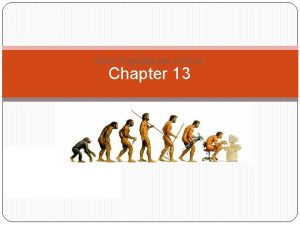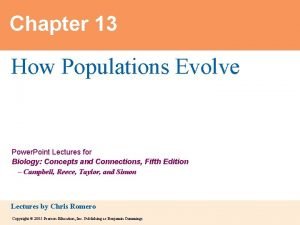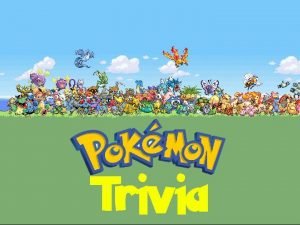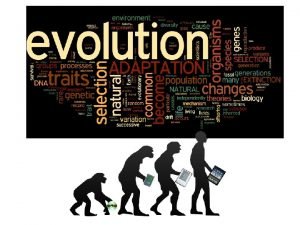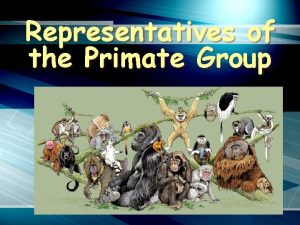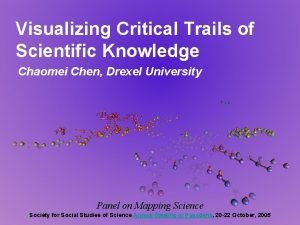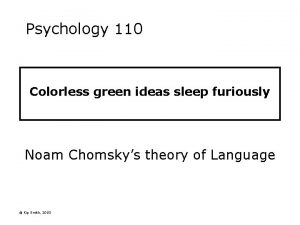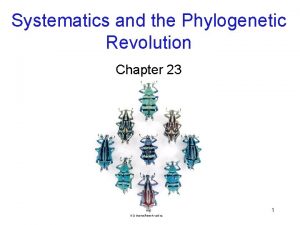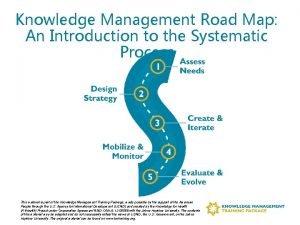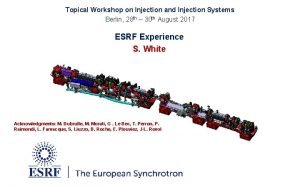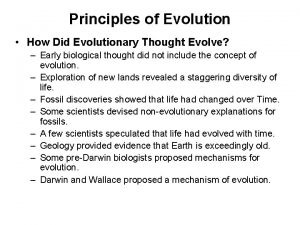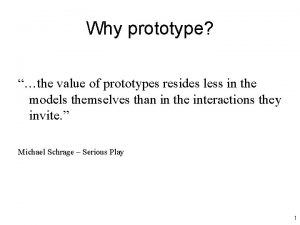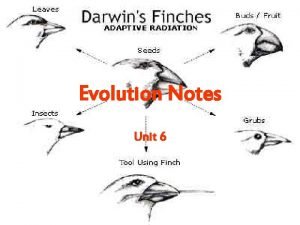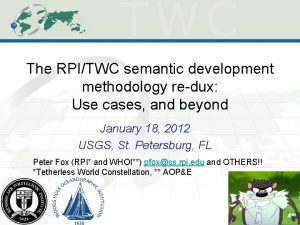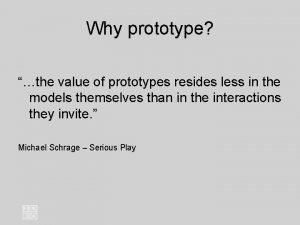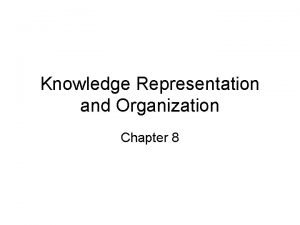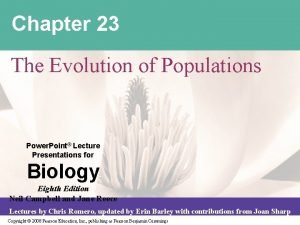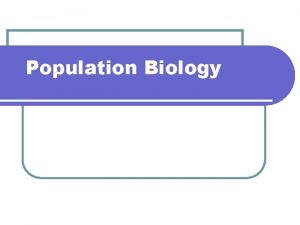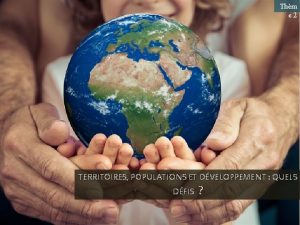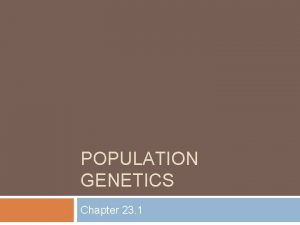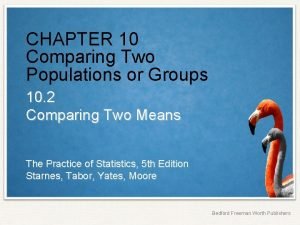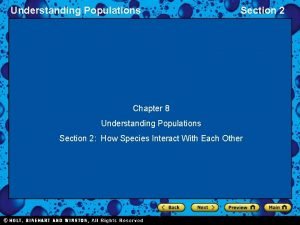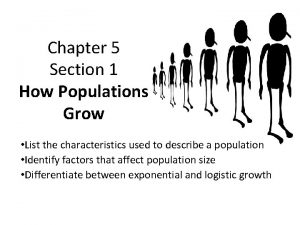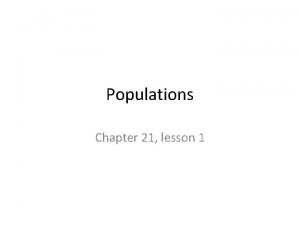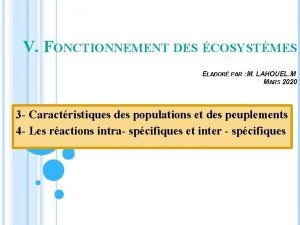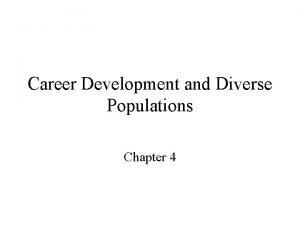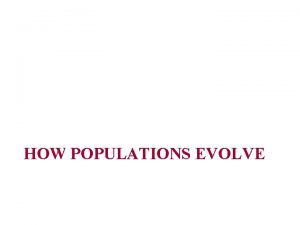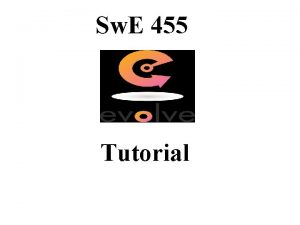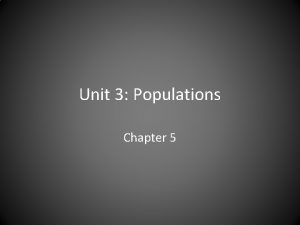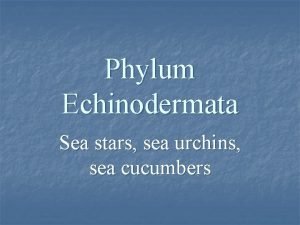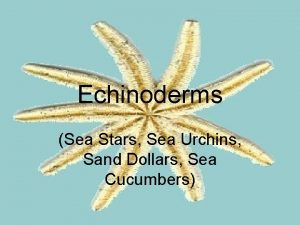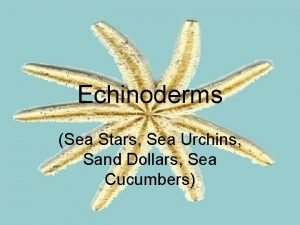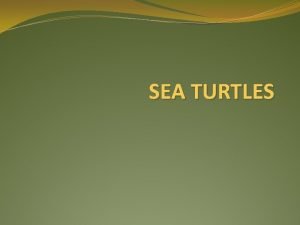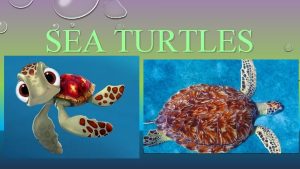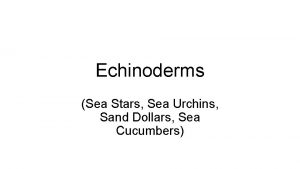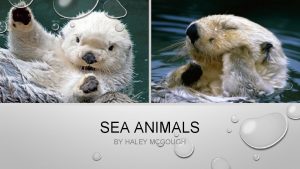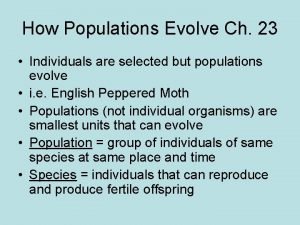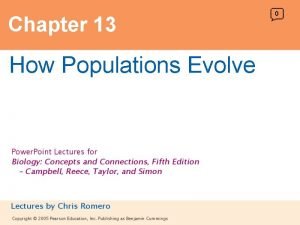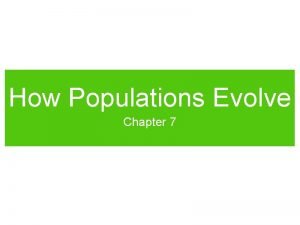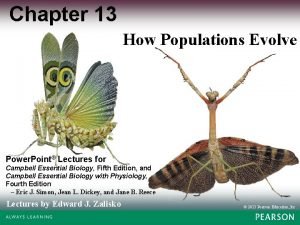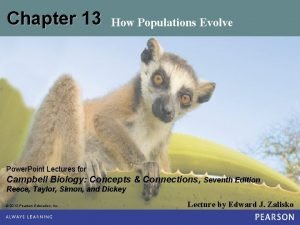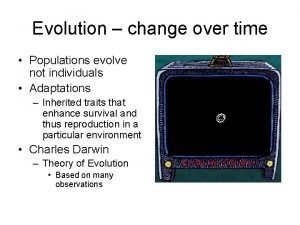CH 13 HOW POPULATIONS EVOLVE A sea voyage











































- Slides: 43

CH. 13 HOW POPULATIONS EVOLVE

A sea voyage helped Darwin frame his theory of evolution HMS Beagle in port Darwin in 1840 Great Britain Europe Asia North America ATLANTIC OCEAN Africa PACIFIC OCEAN Galápagos Islands Pinta South America Marchena Fernandina Isabela 0 0 40 km Pinzón Equator Daphne Islands Santa Cruz Santa San Fe Cristobal Florenza 40 miles Andes Genovesa Santiago Española PACIFIC OCEAN Equator Australia Cape of Good Hope PACIFIC OCEAN Cape Horn Tierra del Fuego Tasmania New Zealand

A sea voyage helped Darwin frame his theory of evolution During his voyage Darwin collected thousands of plants and animals He noted their characteristics that made them well suited to diverse environments. © 2012 Pearson Education, Inc.

A sea voyage helped Darwin frame his theory of evolution In 1859, Darwin published The Origin of Species by Means of Natural Selection – It presented a strong, logical explanation of descent with modification, evolution by the mechanism of natural selection – It noted that as organisms spread into various habitats over millions of years, they accumulated diverse adaptations that fit them to specific ways of life in these new environments. © 2012 Pearson Education, Inc.

Darwin proposed natural selection as the mechanism of evolution Darwin discussed examples of artificial selection, where humans have modified species through selection and breeding Lateral buds Terminal bud Flowers and stems Stem Leaves © 2012 Pearson Education, Inc.

Darwin proposed natural selection as the mechanism of evolution Darwin’s observations: organisms vary in many traits, (most inherited) and can produce more offspring than the environment can support Darwin reasoned that, – Survival depends on inherited traits & organisms with traits that increase their chance of surviving and reproducing in their environment tend to leave more offspring than others – This unequal reproduction will lead to the accumulation of favorable traits in a population over generations © 2012 Pearson Education, Inc.

Darwin proposed natural selection as the mechanism of evolution There are three key points about evolution by natural selection that clarify this process. 1. Individuals do not evolve: populations evolve. 2. Natural selection can amplify or diminish only heritable traits. Acquired characteristics cannot be passed on to offspring. 3. Evolution is not goal directed and does not lead to perfection. Favorable traits vary as environments change.

Scientists can observe natural selection in action Camouflage adaptations in insec © 2012 Pearson Education, Inc.


Scientists can observe natural selection in action Rosemary and Peter Grant have worked on Darwin’s finches in the Galápagos for over 30 years. They found that, – In wet years, small seeds are more abundant and small beaks are favored – In dry years, all seeds are in short supply so birds must eat larger seeds and large, strong beaks are favored

Scientists can observe natural selection in action Another example of natural selection in action is the evolution of pesticide resistance in insects. – A new pesticide may kill 99% of the insect pests, but subsequent sprayings are less effective. – Those insects that initially survived were fortunate enough to carry alleles that somehow enable them to resist the pesticide. – When these resistant insects reproduce, the percentage of the population resistant to the pesticide increases. © 2012 Pearson Education, Inc.

Pesticide application Chromosome with allele conferring resistance to pesticide Survivors Additional applications of the same pesticide will be less effective, and the frequency of resistant insects in the population will grow.

Scientists can observe natural selection in action These examples of evolutionary adaptation highlight two important points about natural selection. 1. Natural selection is an editing process rather than a creative mechanism. 2. Natural selection is contingent on time and place, favoring characteristics in a population that fit the current, local environment. © 2012 Pearson Education, Inc.

The study of fossils provides strong evidence for evolution Darwin’s ideas about evolution also relied on the fossil record, the sequence in which fossils appear within strata (layers) of sedimentary rocks. © 2012 Pearson Education, Inc.

Figure 13. 4 D Fossilized organic matter of a leaf

Many types of scientific evidence support the evolutionary view of life Biogeography, the geographic distribution of species, suggested to Darwin that organisms evolve from common ancestors. Darwin noted that Galápagos animals resembled species on the South American mainland more than they resembled animals on islands that were similar but much more distant. © 2012 Pearson Education, Inc.

Many types of scientific evidence support the evolutionary view of life Comparative anatomy – The comparison of body structures in different species, which indicates that we share a common ancestor – Homology is the similarity in characteristics that result from common ancestry. © 2012 Pearson Edcation, Inc.

Homologous structures have different functions but are structurally similar because of common ancestry. Humerus Radius Ulna Carpals Metacarpals Phalanges Human Cat Whale Bat

THE EVOLUTION OF POPULATIONS © 2012 Pearson Education, Inc.

Evolution occurs within populations A population is a group of individuals of the same species, living in the same place at the same time. Individuals within populations may interbreed. Populations may be isolated from one another (with little interbreeding). We can measure evolution as a change in heritable traits in a population over generations. © 2012 Pearson Education, Inc.

Evolution occurs within populations A gene pool is the total collection of genes in a population at any one time. Microevolution is a change in the relative frequencies of alleles in a gene pool over time. © 2012 Pearson Education, Inc.

Mutation and sexual reproduction produce the genetic variation that makes evolution possible Mutations are changes in the nucleotide sequence of DNA and the ultimate source of new alleles. Sometimes mutant alleles improve the adaptation of an individual to its environment. – more likely when the environment is changing such that mutations that were once disadvantageous are favorable under new conditions. – The evolution of DDT-resistant houseflies is such an example. © 2012 Pearson Education, Inc.

The Hardy-Weinberg equation can test whether a population is evolving Sexual reproduction alone does not lead to evolutionary change in a population. – Although alleles are shuffled, the frequency of alleles and genotypes in the population does not change. © 2012 Pearson Education, Inc.

The Hardy-Weinberg equation can test whether a population is evolving The Hardy-Weinberg principle states that – Within a sexually reproducing, diploid population, allele and genotype frequencies will remain in equilibrium, unless outside forces act to change those frequencies. © 2012 Pearson Education, Inc.

The Hardy-Weinberg equation can test whether a population is evolving For a population to remain in Hardy-Weinberg equilibrium for a specific trait, it must satisfy five conditions. There must be: 1. No mutation 2. No migration (no gene flow between populations) 3. No natural selection 4. Random mating 5. A very large population © 2012 Pearson Education, Inc.

The Hardy-Weinberg equation can test whether a population is evolving Imagine two alleles in a blue-footed booby population, W and w – W (nonwebbed foot) is dominant to w (webbed foot) © 2012 Pearson Education, Inc.

Phenotypes Genotypes WW Ww ww Number of animals (total 500) 320 160 20 Genotype frequencies 320 0. 64 500 160 500 Number of alleles in gene pool (total 1, 000) Allele frequencies 640 W 800 1, 000 0. 32 160 W 160 w 0. 8 W 200 1, 000 20 500 40 w 0. 2 w 0. 04

The Hardy-Weinberg equation can test whether a population is evolving Consider the gene pool of a population of 500 boobies. – 320 (64%) are homozygous dominant (WW) – 160 (32%) are heterozygous (Ww) – 20 (4%) are homozygous recessive (ww) – p = 80% of alleles in the booby population are W – q = 20% of alleles in the booby population are w © 2012 Pearson Education, Inc.

The Hardy-Weinberg equation can test whether a population is evolving The frequency of all three genotypes must be 100% or 1. 0. – p 2 + 2 pq + q 2 = 100% = 1. 0 – homozygous dominant (p 2) + heterozygous (2 pq) + homozygous recessive (q 2) = 100% © 2012 Pearson Education, Inc.

The Hardy-Weinberg equation can test whether a population is evolving What about the next generation of boobies? – The probability that a booby sperm or egg carries W = 0. 8 or 80%. – The probability that a sperm or egg carries w = 0. 2 or 20%. – The genotype frequencies will remain constant generation after generation unless something acts to change the gene pool. © 2012 Pearson Education, Inc.

Sperm Gametes reflect allele frequencies of parental gene pool. W w p 0. 8 q 0. 2 WW Ww p 2 W 0. 64 pq 0. 16 p 0. 8 Eggs w. W w qp 0. 16 ww q 2 0. 04 q 0. 2 Next generation: Genotype frequencies Allele frequencies 0. 64 WW 0. 32 Ww 0. 8 W 0. 04 ww 0. 2 w

The Hardy-Weinberg equation can test whether a population is evolving How could the Hardy-Weinberg equilibrium be disrupted? By the following evolutionary agents/forces. – Small populations could increase the chances that allele frequencies will fluctuate by chance. – Individuals moving in or out of populations add or remove alleles. – Mutations can change or delete alleles. – Preferential mating can change the frequencies of homozygous and heterozygous genotypes. – Unequal survival and reproductive success of individuals (natural selection) can alter allele frequencies. © 2012 Pearson Education, Inc.

MECHANISMS OF MICROEVOLUTION © 2012 Pearson Education, Inc.

Natural selection, genetic drift, and gene flow can cause microevolution The three main causes of evolutionary change are 1. Natural selection 2. Genetic drift 3. Gene flow © 2012 Pearson Education, Inc.

Natural selection, genetic drift, and gene flow can cause microevolution 1. Natural selection – If individuals differ in their survival and reproductive success, natural selection will alter allele frequencies. – Consider the imaginary booby population. Webbed boobies (ww) might – be more successful at swimming, – capture more fish, – produce more offspring, and – increase the frequency of the w allele in the gene pool. © 2012 Pearson Education, Inc.

Natural selection, genetic drift, and gene flow can cause microevolution 2. Genetic drift – Chance fluctuations in allele frequencies due to random events – Genetic drift tends to reduce genetic variation through such losses of alleles from the gene pool Original population © 2012 Pearson Education, Inc. Bottlenecking event Surviving population

Natural selection, genetic drift, and gene flow can cause microevolution 2. Genetic drift, continued – A bottleneck effect is a drastic reduction in population size that can lead to genetic drift – The greater prairie chicken once numbered in the millions (Illinois), but was reduced to about 50 birds by 1993. – A survey comparing the DNA of the surviving chickens with DNA extracted from museum specimens dating back to the 1930 s showed a loss of 30% of the alleles.

Natural selection, genetic drift, and gene flow can cause microevolution 2. Genetic drift, continued – Genetic drift also results from the founder effect, when a few individuals colonize a new habitat – The smaller the group, the less likely the colonists will adequately represent the genetic diversity of the population they left – Therefore, the frequency of alleles will be different between the old and new populations © 2012 Pearson Education, Inc.

Natural selection, genetic drift, and gene flow can cause microevolution 3. Gene flow – The movement (migration) of individuals or gametes/spores between populations can alter allele frequencies in a population. – To counteract the lack of genetic diversity in the remaining Illinois greater prairie chickens, – 271 birds from neighboring states were added to the Illinois populations, successfully introducing new alleles into the population © 2012 Pearson Education, Inc.

Natural selection is the only mechanism that consistently leads to adaptive evolution Genetic drift, gene flow, and mutation cause microevolution, but only by chance can they improve a population’s fit to its environment. Better adapted individuals are more likely to survive and reproduce Only natural selection consistently leads to adaptive evolution (evolution resulting in a better fit between organisms and their environment. ) © 2012 Pearson Education, Inc.

Natural selection is the only mechanism that consistently leads to adaptive evolution An individual’s relative fitness is the contribution it makes to the gene pool of the next generation relative to the contribution of other individuals. The fittest individuals are those that – produce the largest number of viable, fertile offspring thus passing on the most genes to the next generation. © 2012 Pearson Education, Inc.

Natural selection can alter variation in a population in three ways Natural selection can affect the distribution of phenotypes in a population. – Stabilizing selection favors intermediate phenotypes, acting against extreme phenotypes. – Directional selection acts against individuals at one of the phenotypic extremes. – Disruptive selection favors individuals at both extremes of the phenotypic range. © 2012 Pearson Education, Inc.

Frequency of individuals Original population Evolved Original population Phenotypes (fur color) Stabilizing selection Directional selection Disruptive selection
 Gene pool
Gene pool Chapter 13 how populations evolve test
Chapter 13 how populations evolve test Chapter 13 how populations evolve
Chapter 13 how populations evolve Chanson sur le thème du voyage
Chanson sur le thème du voyage Voyage voyage
Voyage voyage Hydra jellyfish sea anemone sea urchin
Hydra jellyfish sea anemone sea urchin Marlin symbolism
Marlin symbolism Troy aegean sea
Troy aegean sea Sea stump
Sea stump Yellow sea and east china sea
Yellow sea and east china sea Educate empower evolve
Educate empower evolve Pokemon elephant
Pokemon elephant Father of evolution
Father of evolution Q
Q Secure assess evolve
Secure assess evolve Apqc
Apqc Evolve knowledge
Evolve knowledge Evolve windows xp
Evolve windows xp Colorless green ideas sleep furiously
Colorless green ideas sleep furiously Evolve secureassess
Evolve secureassess Most complex characters evolve
Most complex characters evolve Evolve knowledge
Evolve knowledge Evolve berlinist
Evolve berlinist Evolve
Evolve Explore evolve validate prototype
Explore evolve validate prototype Evolve
Evolve Evolve
Evolve Evolve knowledge
Evolve knowledge Explore evolve validate prototype
Explore evolve validate prototype Evolve knowledge
Evolve knowledge Chapter 23 the evolution of populations
Chapter 23 the evolution of populations Chapter 10 comparing two populations or groups answer key
Chapter 10 comparing two populations or groups answer key Population definition
Population definition Territoires populations et développement quels défis
Territoires populations et développement quels défis Genetic drift in small populations
Genetic drift in small populations Chapter 10 comparing two populations or groups
Chapter 10 comparing two populations or groups Chapter 8 understanding populations
Chapter 8 understanding populations Chapter 5 lesson 1 how populations grow answer key
Chapter 5 lesson 1 how populations grow answer key Evolution of populations section 16-1 genes and variation
Evolution of populations section 16-1 genes and variation Lesson 1 populations answer key
Lesson 1 populations answer key Dynamique des populations
Dynamique des populations Career development of diverse populations
Career development of diverse populations Population growth concept map answers
Population growth concept map answers Stabilizing selection human birth weight
Stabilizing selection human birth weight

